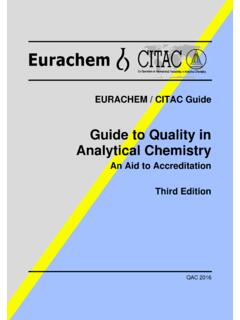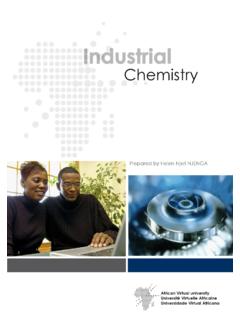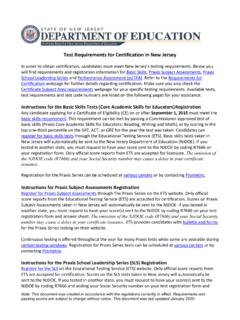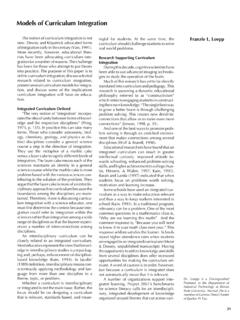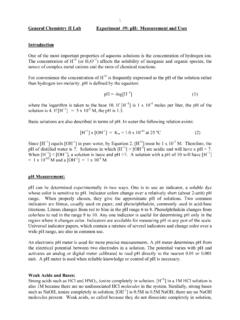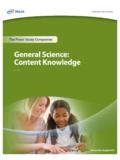Transcription of Setting Up Science Laboratories Basic Guidelines
1 Setting Up Science LaboratoriesBasic Guidelines Compilers: Rooshi Abedi Kashif Hussain Afreen Kanwal Reviewer: Dr Shehzad Jeeva Zain-ul-Muluk Editor: Raabia Hirani Composer: Akber Hashmani Published by Aga Khan University Examination Board Block C , IED-PDC, 1-5/B-VII, Area, Karimabad Box 13688 Karachi-75950, Pakistan Revised July 2015 All rights reserved This booklet is produced by the Aga Khan University Examination Board for distribution to all its affiliated schools. TABLE OF CONTENTS Section I: Introduction 1 Importance of Practical Activities .. 1 Section II: Requirements 1 Number of Laboratories .. 2 Laboratory Conditions .. 2 Chemical Storage and Disposal .. 2 Section III: Safety in Science Laboratories 5 Safety Rules for Teachers .. 5 Safety Rules for Students .. 6 Section IV: Emergency Responses for Laboratory Accidents 8 Annexure A: Science Apparatus and Consumables 9 Setting up Biology Laboratory (SSC).
2 9 Setting up Biology Laboratory (HSSC) .. 15 Setting up chemistry Laboratory (SSC) .. 20 Setting up chemistry Laboratory (HSSC).. 25 Setting up Physics Laboratory (SSC).. 30 Setting up Physics Laboratory (HSSC) .. 33 Setting up Computer Science Laboratory (SSC and HSSC) .. 36 Annexure B: Safety Signs 37 Annexure C: System International Units 39 Annexure D: Periodic Table 42 Setting up Science Laboratories Basic Guidelines Page 1 Section I: Introduction Importance of Practical Activities The Aga Khan University Examination Board (AKU-EB) aims to create opportunities to provide students with hands-on experience of laboratory experiments which could bridge the gap between theoretical concepts and its application in everyday life. The laboratory performance is based on the idea that Science focuses on hands-on, minds-on observational activities, and that these activities help students in making connections between various scientific concepts and real life experiences.
3 If students are to make use of any technology/ scientific skills in their classrooms, they must learn to make observations; formulate hypotheses; conduct experiments; collect data; use appropriate tool; analyse the data and interpret the obtained results. Following aforementioned steps during practical activities will enable students to make connections to other areas of Science and communicate the information effectively and argue their conclusions logically. Students can learn these skills if they are able to participate in a variety of laboratory exercises. The information provided in this document will act as a guide to set up Science Laboratories which is one of the important criteria for affiliation with AKU-EB. To promote effective teaching and learning, the involvement and commitment on the part of administration and teachers is essential.
4 Section II: Requirements The table below indicates the number of units (periods) allocated per week for practical activities to be conducted in a year in the respective subjects. Table 1: Unit Allocation for Practical Activities per Week Subject Units/ Week* Biology at least TWO chemistry at least TWO Physics at least TWO Computer Science at least TWO *Units/ Week for practical activities (The duration of each unit should not be less than 45 minutes.) Setting up Science Laboratories Basic Guidelines Page 2 Nu mber of La bo ra to ries In order to meet the demand for different aspects of Science , ideally a school should have one laboratory each for Biology, chemistry , Physics and Computer Science . The schools with one Science laboratory common for Biology, chemistry and Physics should satisfy the demand of every subject (for instance, minimum 3 sinks, running water supply, gas feed and 6 electrical sockets).
5 If a laboratory must be shared, the Science teachers involved should devise a fair schedule which allows sufficient time for each subject. Laboratory Co n di tio n s Preferably, Laboratories should be constructed at a distance from the other classrooms for health and safety reasons. Each laboratory should offer a minimum accommodation of 6 workstations. The Laboratories should have good ventilation, should be well-illuminated and spacious enough to avoid congestion during the practical activities. In order to accomplish the objectives of the syllabi, the Laboratories should be well equipped with necessary apparatus (see Annexure A) and resources such as gas, electricity and water. It is highly recommended that there should be at least one fume cupboard in the laboratory which is placed away from the workstations for a safe demonstration.
6 A fume cupboard is a ventilated enclosure built into the wall of a laboratory in which harmful and volatile chemicals can be used or stored. In addition, the closed sash protects against splashes of hazardous substances or shattering glass in case of explosion. Thus, the fume cupboard ensures a safe atmosphere in the laboratory. Chemical Storage and Disposal It is recommended that the Laboratories are provided with a store room for the preparation and storage of reagents. Up dat e inventory of all chemicals on hand at least annually; keep the inventory list up-to-date. Do not store chemicals past the manufacturer s suggested shelf-life. Generally, bottles of chemicals should not remain unused on shelves in the laboratory for more than one week and in the storeroom unused for more than one year.
7 As a good practice, ensure that appropriate disposal procedures for waste chemicals are followed as per environmental protection requirements. Do not purchase or store large quantities of flammable liquids. Never open a chemical container until the label and Material Safety and Data Sheet (MSDS) have been read and completely understood. Setting up Science Laboratories Basic Guidelines Page 3 According to American Chemical Society s publication, preventing accidents with chemicals involves two requirements: knowledge and the habit of safety. Knowledge entails understanding the particular hazardous characteristics of a chemical that will be used. Is it flammable? Is it toxic? Knowledge also means knowing what to do and what to avoid when a chemical is flammable, corrosive or an irritant. Moreover, knowledge includes knowing what to do in case an accident occurs.
8 In addition to knowledge, developing habit of safety is also essential which means following safety rules in the Science Laboratories by teachers and students. Precautionary labels for chemicals typically present information in four parts, usually in the order described here. First is a Signal Word: Danger , Warning , or Caution . Only one of the three should be used on a label. Danger is the strongest of the three and is used when the contents present a potential for serious foreseeable harm. Caution is restricted to chemicals that are foreseeably the least potentially harmful. Warning is for chemicals intermediate in their potential to cause foreseeable harm. One or more Statements of Hazard follow the Signal Word. These are brief descriptions of the major foreseeable way or ways in which the chemical could cause harm.
9 Examples include: Flammable Harmful if Inhaled Causes Severe Burns Poison May Cause Irritation Next on the label are one or more Precautionary Measures, as appropriate. These are brief descriptions of actions to be undertaken or avoided and which, if followed, will prevent the corresponding hazard(s) that are described by the Statements of Hazard. Examples include: Keep Away from Heat, Sparks, and Flame Use with Adequate Ventilation Do Not Get in Eyes Avoid Breathing Dust At the end, the label displays some ways in which one can quickly respond to an accident, provide First Aid. For example, IF ON CLOTHING/ SKIN: Rinse immediately contaminated clothing or skin with plenty of water. IF IN EYES: Rinse with water for several minutes. Source: Setting up Science Laboratories Basic Guidelines Page 4 A pictogram, a pictorial safety sign, may also be included on the label which would quickly communicate the hazard of the chemical.
10 Thus, chemicals in the laboratory should ideally be labelled as shown in the example below. Pictogram: Signal Word: Danger Hazard Statement: Causes severe skin burns and eye damage/ highly corrosive. Prevention: Wear protective gloves, safety goggles and face shield with chin guard. Wash arms, hands and face thoroughly after handling. Response: IF ON SKIN: Rinse skin with water. IF ON CLOTHING: Rinse immediately contaminated clothing and skin with plenty of water. Wash contaminated clothing before reuse. IF IN EYES: Rinse cautiously with water for several minutes. Remove contact lenses, if present and easy to do. Continue rinsing. IF SWALLOWED: Rinse mouth. Do NOT induce vomiting. Seek medical assistance soon after receiving first aid. Source: Setting up Science Laboratories Basic Guidelines Page 5 III: Safety in Science Laboratories Safety Rules for Teachers Following points are highly recommended for providing a healthy and safe environment during practical activities: 1.



